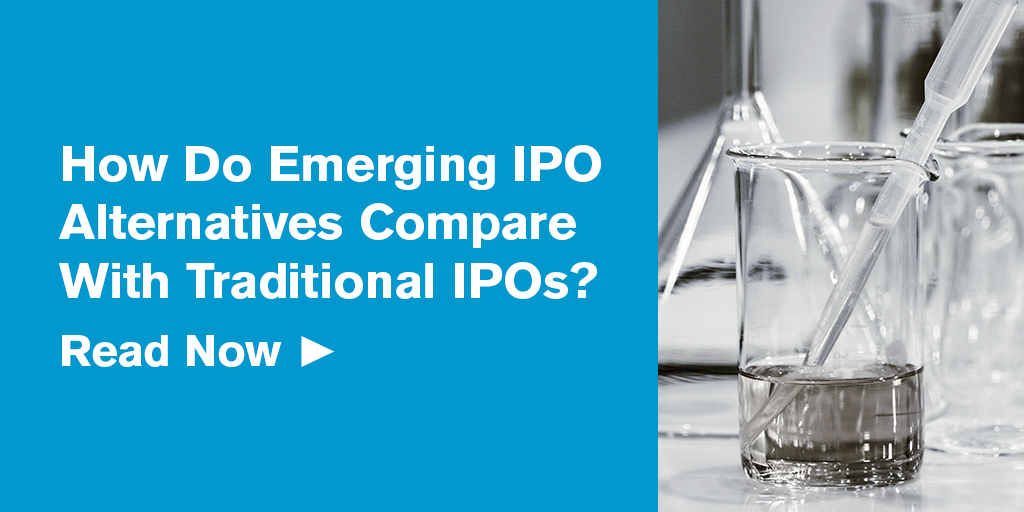NASDAQ Direct Listing Adds to Growing List
The initial public offering, or IPO, has long been seen as the natural next step for life science businesses that have run their course of private investment. And for mature companies, IPOs remain a great way to raise capital while allowing founders to get some hard-earned rewards for the company they have built. But for others, the cost and the loss of control over the company make IPOs less attractive. Thankfully for these businesses, today’s life science companies have multiple viable alternatives to IPOs that can allow them to accept public investment without going through the traditional IPO process. With that in mind, here is how two popular emerging IPO alternatives compare with the traditional IPO route for life science companies.
Initial Public Offering
Before breaking down its alternatives, let us recall the basics of an IPO. An IPO allows a private company to raise interest-free capital by offering up its shares on one or more stock exchanges. This can be a good move for viable life science startups that are running up against the end of their Series Preferred venture capital fundings and are unable to further tap the well, so to speak, to raise more cash. However, the very nature of an IPO, which creates new shares in order to sell to the public, necessarily entails at least one of the company’s current owners will see their stake in the company diluted.
There are also significant costs involved with in IPO, such as paying an underwriter (usually an investment banker) who takes care of the logistical and legal aspects of listing the company on the stock market, such as setting a target price — and charges a steep commission for that work, typically between 3% and 7%. Furthermore, one consideration motivating companies to seek alternatives to IPOs is suspicion on behalf of venture capital firms that investment banks intentionally underprice IPO target prices to secure big gains for investors.
There are a number of other costs, too. For instance, to give the IPO the best chance of success, the company must market itself effectively to the public, and that usually entails paying large sums to drum up interest with institutional investors, analysts, hedge fund managers, and other influential parties via so-called “roadshows.” And moreover, while owners can stand to make quite a bit of money selling their shares as the value of the business increases, the company has to sell all the shares that it is offering up to the market on Day 1, meaning it does not make any additional money other than the amount for which it sells the interest should the stock price increases.
Direct Listing
One IPO alternative that has garnered significant headlines in recent weeks is the direct listing, also known as a direct public offering (DPO). In response to increasing demand for alternatives to IPOs, the Nasdaq stock exchange in August filed with regulators to change its rules and enable companies to debut on its stock market via DPO. This follows a similar request from the New York Stock Exchange (NYSE) back in June.
While companies like Amazon and Apple have used a process similar to the DPO offering previously to bring stocks to the public market, the idea of a DPO as a means for a private company to go public is still a relatively novel idea. That being said, direct listings for other purposes have been occurring for decades. This kind of direct listing allows anyone who holds shares in the company to sell those shares. As opposed to an IPO, the company issuing the DPO sets the target price, minimum investment per investor, and all the other terms of the offering itself.
Historically, the biggest difference between an IPO and a traditional direct listing was that the latter does not raise new capital for the company. Its purpose is merely to allow existing investors to cash in their shares. Recently, however, the Securities and Exchange Commission has approved the NYSE’s plan to create a new type of direct listing in which companies can issue new shares. This means businesses can now take advantage of the benefits of a DPO and raise new capital for their companies at the same time. Probably the biggest of those advantages is that the DPO process allows companies to avoid a lot of the costs associated with an IPO. For instance, because certain regulatory and reporting requirements associated with an IPO are not required of DPOs, companies can complete a DPO without the assistance of an underwriter. Furthermore, DPOs do not come with lockup periods, the (typical) 90 to 180 days that company insiders must wait before selling their shares in a traditional IPO.
However, there are numerous potential risks to this approach that companies must weigh. Precisely because a DPO does not go through the usual IPO channels there is no guarantee that anyone will purchase the shares that are for sale. Companies can also expect much less publicity regarding the event and a potentially high degree of volatility because there is no set price.
Additionally, the stock is not freely traded and there is no set market for the shares, which makes it highly subject to market demands. In particular, a company that completes a DPO will — unlike a company that goes public via IPO — not have a strong trading platform like the Nasdaq or New York Stock Exchanges in which its shares can be bought and sold. While they may choose to trade their stocks in over-the-counter (OTC) markets, OTC securities must be registered and adhere to Sarbanes-Oxley Act requirements or else face risks like illiquidity.
Finally, in practice DPOs have typically commanded lower prices than they might have through an IPO.
Special Purpose Acquisition Company (SPAC)
If the intended purpose of an IPO is for company leaders to sell their shares and make their exits, one alternative that merits consideration is selling to a special purpose acquisition company, or SPAC. SPACs are typically created by experienced private equity fund managers with a given target business in mind (although for regulatory reasons the SPAC manager does not usually disclose which company that is). Like a company pursuing an IPO, to raise money for the purchase, the SPAC typically secures investments from underwriters and institutional investors before offering shares to the public. Once the fundraising is complete, the SPAC must either spend the cash on an acquisition or else return investors’ money.
As you might expect, the SPAC manager’s (or managers’) reputation for successful returns heavily determines their chance at successfully raising funds. And obviously, your business has to be attractive enough to the investor community for a SPAC for it to be an option — though many life science startups are. But what is the benefit for the owners of the company? It is simple: Businesses who sell to a SPAC can often sell at a significant premium over what they might get in a private equity deal. Additionally, being acquired by a SPAC can be substantially faster than going through the IPO process.
Not Sure Which Approach Is Right for Your Business? Ask BPM.
Life science are a key industry focus for BPM. From advising clients on transactions and conducting IPO readiness assessments, to crafting effective exit strategies and conducting valuations or appraisals, the professionals in BPM has the expertise to help life science businesses of any size and at any stage of the lifecycle reach their fundraising goals. And with decades of experience working with both public and private life science companies, you can trust that our Life Science Industry Group has the specialized technical experience needed to provide world-class service.
To learn more about how we can assist your business, contact Michael VanderKlugt, Life Science Industry Group co-leader, today.
 The initial public offering, or IPO, has long been seen as the natural next step for life science businesses that have run their course of private investment. And for mature companies, IPOs remain a great way to raise capital while allowing founders to get some hard-earned rewards for the company they have built. But for others, the cost and the loss of control over the company make IPOs less attractive. Thankfully for these businesses, today’s life science companies have multiple viable alternatives to IPOs that can allow them to accept public investment without going through the traditional IPO process. With that in mind, here is how two popular emerging IPO alternatives compare with the traditional IPO route for life science companies.
The initial public offering, or IPO, has long been seen as the natural next step for life science businesses that have run their course of private investment. And for mature companies, IPOs remain a great way to raise capital while allowing founders to get some hard-earned rewards for the company they have built. But for others, the cost and the loss of control over the company make IPOs less attractive. Thankfully for these businesses, today’s life science companies have multiple viable alternatives to IPOs that can allow them to accept public investment without going through the traditional IPO process. With that in mind, here is how two popular emerging IPO alternatives compare with the traditional IPO route for life science companies.
